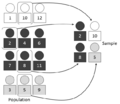Random sample facts for kids
A random sample is like picking names out of a hat when everyone has an equal chance to be chosen. It's a small group of things or people chosen by chance from a much larger group. When you pick a random sample, you want to make sure that every single item or person in the big group has the same opportunity to be picked. This helps you get a fair and accurate idea about the whole group without having to check every single person or thing.
Contents
What is a Random Sample?
Imagine you have a big jar full of different colored candies. If you want to know how many of each color there are without counting every single candy, you could take a random sample. You would reach into the jar without looking and pull out a handful. If you do this many times, the colors in your handfuls should give you a good idea of the colors in the whole jar.
The main idea of a random sample is that there's no special reason why one item is picked over another. It's all about chance! This is super important because it helps make sure your results are fair and not biased.
Why Random Samples Are Important
Random samples are used all the time to learn about big groups of people or things. For example, imagine a company wants to know if kids like their new video game. They can't ask every kid in the world! So, they pick a random sample of kids to play the game and give their opinions. If the sample is truly random, the opinions of these kids will likely be similar to what all kids would think.
Here are some places where random samples are used:
- Surveys and Polls: When you hear about polls saying how many people like a certain politician or a new product, they usually got that information from a random sample.
- Science Experiments: Scientists use random samples to test new medicines or ideas. They might randomly choose people for a study to make sure the results are fair.
- Quality Control: Factories might randomly check a few items from a big batch to make sure everything is being made correctly.
How to Get a Random Sample
Getting a truly random sample can be tricky! Let's think about an election poll. If you want to know who people will vote for, you might think calling people from a phone book is a good idea. It's better than just asking people at a specific meeting, like a club meeting, because a phone book has many different kinds of people.
However, even a phone book isn't perfectly random. Why? Because some people don't have phones, or their numbers aren't listed. This means those people don't have a chance to be picked. So, the sample wouldn't include everyone, and it might not be a perfect picture of all voters.
To get a better random sample, people often use computers to generate random numbers. Each person or item in the big group gets a number, and then the computer picks numbers randomly. This helps make sure everyone has an equal shot at being chosen.
Different Ways to Sample Randomly
There are different ways to take a random sample, depending on what you're studying:
- Simple Random Sampling: This is like picking names from a hat. Every single person or item has an equal chance of being chosen.
- Systematic Sampling: Imagine you have a list of people. You might pick every 10th person on the list. As long as you start at a random spot, this can be a good way to get a random sample.
- Stratified Sampling: Sometimes, you want to make sure your sample includes a certain number of people from different groups. For example, if you're studying students, you might want to make sure you have a certain number of 6th graders, 7th graders, and 8th graders in your sample. You would randomly pick from each of those groups.
- Cluster Sampling: This is used when the big group is spread out. You might randomly pick a few "clusters" (like specific schools or neighborhoods) and then survey everyone in those chosen clusters.
Images for kids
See also
 In Spanish: Muestreo (estadística) para niños
In Spanish: Muestreo (estadística) para niños





